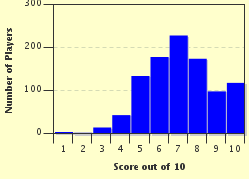Quiz Answer Key and Fun Facts
1. The show opens with "The Professor's Song", which includes a reference to trying to remember the equation F=-kx. By what name is this law, which describes the extension of a spring when a force is applied to it, known?
2. The next song in the Physical Revue is titled "s is one-half g(t squared)". Which of the following other physical laws (relevant to astronomy) is NOT featured in the lyrics?
3. The song "Relativity" has lyrics by Tom Lehrer, and music from a song called "Personality" by James Heusen. The lyrics include "'Twas Mr. _____'s brainchild - Relativity." Whose name should go in the blank?
4. "The Derivative Song" describes what is usually known as Newton's Method for finding the derivative of a function. What branch of mathematics is concerned with differentiation?
5. This show features a performance of a song that Lehrer later released in solo performance, "Lobachevsky". According to this song, what is the secret of success in the world of physics? It's not allowed here at FunTrivia.
6. Tom Lehrer's song "The Elements" is a patter song, to the tune of "I Am the Very Model of a Modern Major General", written by Gilbert and Sullivan for their show "The Pirates of Penzance". How many elements does Lehrer include in the song?
7. From what stage musical does the song which Tom Lehrer adapted for "A Litre and a Gram" come?
8. "There's a Delta for Every Epsilon" describes the conditions governing whether or not a function has a limit at a given point, and bemoans the fact that poor Epsilon only gets a Delta under what condition?
9. The song "Hail Chemistry" is yet another song for which Lehrer got his musical inspiration from Sir Arthur Sullivan. Which piratical operetta contains the song "Hail Poetry"?
10. In "The Slide Rule", for what illicit purpose does Tom Lehrer recommend that students use their slide rules?
Source: Author
looney_tunes
This quiz was reviewed by FunTrivia editor
ertrum before going online.
Any errors found in FunTrivia content are routinely corrected through our feedback system.

